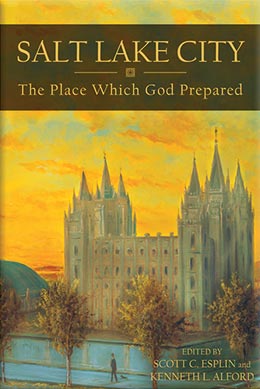Susan Easton Black, “The Beehive and Deseret: Mormon Symbols in Salt Lake City,” in Salt Lake City: The Place Which God Prepared, ed. Scott C. Esplin and Kenneth L. Alford (Provo, UT: Religious Studies Center, Brigham Young University; Salt Lake City: Deseret Book, Salt Lake City, 2011), 119–132.
Susan Easton Black is a professor of Church history and doctrine at Brigham Young University.
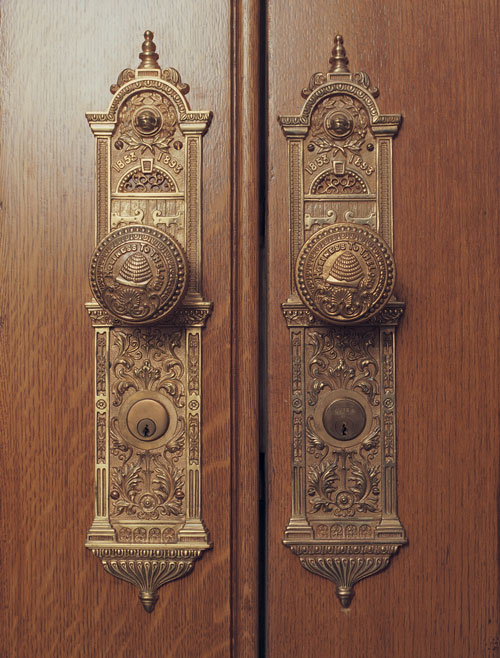 Beehives on the doorknobs of the Salt Lake Temple. (© Intellectual Reserve, Inc.)
Beehives on the doorknobs of the Salt Lake Temple. (© Intellectual Reserve, Inc.)
When looking for symbols of the Book of Mormon in Salt Lake City, there is nothing so evident as the beehive and an obscure word buried in the book of Ether: “And they did also carry with them deseret, which, by interpretation, is a honey bee; and thus they did carry with them swarms of bees” (Ether 2:3). The honeybee, depicted on heroic-sized beehives, is seen atop such prominent buildings as the Beehive House and Joseph Smith Memorial Building in downtown Salt Lake City. Smaller replicas of the beehive have been stamped on license plates, park benches, and other objects. Monuments and souvenirs galore tout the beehive as the symbol of Salt Lake City much as Atlanta claims the peach as its symbol. To Latter-day Saint residents of Salt Lake City, the beehive is more than a symbol of the city as a home of hard workers or of industry. The beehive symbol was Brigham Young’s way to remind residents of the Jaredite civilization in America.
This paper will show that in the 1840s the symbol of the beehive and the word deseret were not yet wedded as one. In fact, the two words were not linked together until after the Latter-day Saints had a foothold in the Great Salt Lake Valley. It was then that Deseret was chosen as the name of the Mormon territory in the West and the beehive symbol adopted as the state symbol. This paper will trace the beehive’s rise to prominence in Salt Lake City and the reasons that the word deseret took center stage in the valley. It will also show that as the federal government intervened to prevent the creation of a state called Deseret, the beehive symbol gained widespread acceptance but the term deseret lost favor, retaining importance only as a trademark of Church-owned entities.
The Beehive Symbol Is Introduced into Mormon Society
Some Latter-day Saint scholars link the word beehive to the ancient Jaredite word deseret, meaning honeybee (see Isaiah 7:18; 2 Nephi 17:18). The words share an obvious organic connection but not the same precise definition. Adding to the potential confusion, some have suggested that the beehive and deseret are symbols of industry. Kevin L. Barney states that Brigham Young chose the beehive symbol and the word deseret because he “liked the imagery of cooperative labor and industry brought to mind by honeybees and their hives.” [1] S. S. Ivins agrees with Barney, claiming that Brigham chose “the honey bee as their symbol of industry.” [2] W. Jeffrey Marsh adds that deseret is “a Book of Mormon term for honeybee, signifying unity, industry, and cooperation.” [3]
Hugh Nibley says there is more to the beehive symbol than the simplistic view of industry and cooperation. He points out that there is great significance in the fact that the Jaredites brought swarms of honeybees to the new land. According to Nibley, the transporting of bee swarms was a common practice among ancient Egyptians, who held the “bee sign” to be sacred. Nibley sees a strong correlation between the Jaredites, the honeybee, and early practices in Lower Egypt. [4] He writes, “The bee, like the red crown, was identical with the majesty of Lower Egypt. . . . The bee symbol spread in other directions from its original home, enjoying a prominent place in the mysteries of the Hittites, the Finnish, and surviving in some nations in certain Easter rites.” Nibley also points out, “In certain editions of the Book of Mormon, though not the first, the word deseret is capitalized, for the editors have recognized that it is really a title. . . . One might be justified, though we will not insist on it, in seeing in Deseret the national symbol or as it were the totem of Jared’s people.” [5] Paul Y. Hoskisson cautions that uncovering the meaning of the word deseret and the purpose for the Jaredites bringing honeybees to the new land should be left to the future, for “unless and until it can be determined from which cultural background the Jaredites departed, it will be impossible to do anything but guess about etymologies for Jaredite names,” including the name deseret. [6]
A few Latter-day Saint historians suggest that because the beehive is prominent in the Third Degree of Freemasonry, Freemasonry introduced Brigham to the symbol. [7] According to Masonic scholar Allen E. Roberts, “The bee . . . works hard and tirelessly, not for himself, but for the swarm. He has a strength and knowledge of materials that cannot be duplicated. He works in complete cooperation, and without dissension, with his fellow bees. He protects the Queen, refuses admittance to enemies, builds, makes honey, and lives in a society ruled by law.” [8] In his attempt to link bees to the activities of Freemasonry, Roberts writes of the ancient Masonic lodge as a “Hive of Free-Masons.” He calls dissensions that threaten the hive and attempts to separate and form new lodges “swarming,” a reference to the pattern of bees and ancient masonry. [9] What historians fail to recognize is that the beehive symbol was introduced and placed in circulation in Nauvoo over a year before Freemasonry officially entered town. [10]
On February 27, 1841, Governor Thomas Carlin signed into law “an Act to Incorporate the Nauvoo Agricultural and Manufacturing Association.” [11] The purpose of the association was to promote agriculture and husbandry and to manufacture flour, lumber, and other necessary articles. According to the act, capital stock in the association (a maximum of $100,000) was to be subdivided into $50 shares. Shares or stock certificates were to be numbered and dated before being issued. On the face of each certificate the symbol of the beehive was to appear. [12]
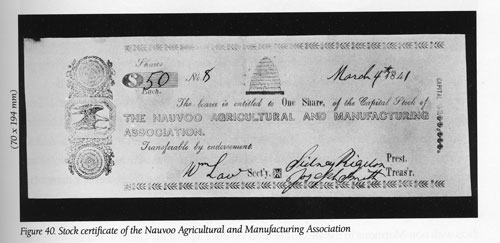 The first official use of the beehive in Mormon society was on a fifty-dollar share of the Nauvoo Agricultural and Manufacturing Association. Alvin E. Rust, Mormon Utah Coin and Currency (Salt Lake City: Rust Rare Coin, 1984), 31.
The first official use of the beehive in Mormon society was on a fifty-dollar share of the Nauvoo Agricultural and Manufacturing Association. Alvin E. Rust, Mormon Utah Coin and Currency (Salt Lake City: Rust Rare Coin, 1984), 31.
The Nauvoo Agricultural and Manufacturing Association made no attempt to mention or link the beehive to deseret on the certificates. This is of particular interest because each certificate issued was signed by Joseph Smith Jr., Sidney Rigdon, and William Law, the First Presidency of the Church. Likewise, published accounts of meetings and suggestions given for improving agricultural and manufacturing output in Nauvoo did not reference the word deseret. [13]
It was Peter Haws, one of seven principals of the association, [14] who kept the beehive symbol in circulation among Latter-day Saints long after the Nauvoo Agricultural and Manufacturing Association had become defunct. While camped at Garden Grove in Iowa Territory, Peter embossed on the front side of a brass token dated 1846 an ornate beehive with the slogan “Do Your Duty.” On the obverse side, he embossed clasped hands with the motto “Union Is Strength.” [15] His token was circulated in Garden Grove and throughout Pottawattamie County and used as a barter or exchange among Latter-day Saints. As the Nauvoo Agriculture and Manufacturing Association certificates, there was no attempt by Peter Haws to link the beehive symbol to deseret. [16]
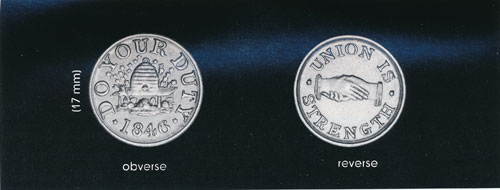 Haws’s 1846 brass token with beehive (variety 1). (Rust, Mormon and Utah Coin and Currency, 34.)
Haws’s 1846 brass token with beehive (variety 1). (Rust, Mormon and Utah Coin and Currency, 34.)
The Jaredite Word Deseret Becomes a Household Word in Mormon Society
In 1849, Brigham Young and a committee consisting of Heber C. Kimball, Willard Richards, John Taylor, and John M. Bernhisel introduced the word deseret into the everyday vocabulary of Salt Lake City residents. The committee, with Brigham acting as lead, met to create and approve a memorial requesting that the US Congress charter “a Territorial Government of the most liberal construction authorized by our excellent Federal constitution, with the least possible delay, to be known by the name of Deseret.” [17] The memorial argued that Deseret should be included within the United States because “all political power is inherent in the people; inhabitants of a region are best qualified to judge the type of government suited to their needs.” [18] The memorial proposed the boundaries of the new territory be “Oregon on the north, the Green River on the east, Mexico on the south, and the Sierra Nevada on the west, including a portion of the Southern California seacoast.” [19] The committee approved a twenty-two-foot-long memorial containing 2,270 signatures signed in support of the proposed territorial status of Deseret. [20] On May 3, 1849, Dr. John M. Bernhisel left Salt Lake City bound for Washington DC with the memorial in hand. [21] In the nation’s capitol, his efforts and that of other leading Latter-day Saints to advance the cause of Deseret were thwarted at every turn.
In the meantime, the State of Deseret functioned without federal approval for nearly two years under a formal constitution based upon the US Constitution and the Iowa Constitution of 1846. The preamble to the Deseret Constitution says, “We the People, Grateful to the Supreme Being for the blessings hitherto enjoyed, and feeling our dependence on Him for a continuation of these blessings, do ordain, and establish a free and Independent Government, by the name of the State of Deseret.” [22] No mention was made in constitution of the beehive symbol, nor was it mentioned at rhetorical occasions such as speechmaking. The same could be said about other planned activities of the State of Deseret. For example, there was no mention of the beehive in the elections held in the bowery to determine which officials would govern the State of Deseret. The General Assembly of the State of Deseret passed ordinances regulating elections and the militia, creating a judiciary system, establishing roads and waterways, and incorporating the Perpetual Emigrating Company and The Church of Jesus Christ of Latter-day Saints. In addition, the general assembly incorporated cities and established the University of Deseret. [23] The board of regents of the university approved the Deseret Alphabet. [24] Then came the first newspaper in Salt Lake City, the Deseret News. [25] It is noteworthy that Eliza R. Snow celebrated the proposed State of Deseret in a children’s song:
In our lovely Deseret,
Where the Saints of God have met,
There’s a multitude of children all around.
They are generous and brave;
They have precious souls to save;
They must listen and obey the gospel’s sound. [26]
On September 9, 1850, US President Millard Fillmore signed an act creating the Territory of Utah. When word was received in Salt Lake City of the president’s executive decision, Brigham Young ordered the General Assembly of Deseret to dissolve the State of Deseret on April 5, 1851, in favor of the territorial status of Utah.
Deseret and the Beehive Symbol as One
Although the initial proposal was rejected, Brigham did not discard his plans for a State of Deseret within the United States. As governor of the Territory of Utah, Brigham ordered the building of the Beehive House as his official residence and office in 1854 (note that he did not order the building of a Utah House). More than any other residence in Salt Lake City, construction of the Beehive House sent a signal of Brigham’s continued hopes and plans for a State of Deseret. In reference to these hopes, he said, “[We will] sustain in time to come our free and glorious institutions to the latest generation.” [27] Atop his newly constructed house was placed a gilded beehive. Beehives also adorned the interior of the home, with multiple beehives etched into stair railings. Latter-day Saint residents of the city, believing there was a message in the Beehive House, embraced the beehive as the symbol of Deseret and followed Brigham’s example. Soon the beehive symbol, now a reference to the hoped-for State of Deseret, appeared in business and residential districts throughout the city. To many, it was a symbol of defiance—a way to visibly show irritation with federal government interference. To others, it conveyed a willingness to persist in establishing Deseret as a state within the United States. In spite of the replicated beehive symbols throughout the city, the drafting of new constitutions, and the boundary changes made to fit within the prescribed limits of Utah Territory, efforts to create the State of Deseret within the Union failed in 1856, 1862, and 1872. [28]
Frustrated, if not angered, by repeated rejections, Brigham redoubled his efforts to link deseret with the beehive symbol. Take, for instance, the Deseret Agricultural and Manufacturing Society, a society similar in composition to the Nauvoo Agricultural and Manufacturing Association of 1841. Brigham Young was president of the new society and, as such, selected the beehive as the society’s symbol. Next came the Deseret Currency Association, the first banking establishment in the city. Brigham Young was president of that association also. One purpose of the association was to provide a medium of exchange because US coins were rare in the city. On the notes and certificates issued by the society was the familiar beehive. [29] The difference between these notes and certificates and those issued in Nauvoo was the direct link between deseret and the beehive.
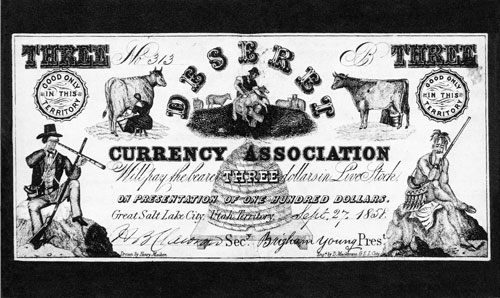 A three-dollar Deseret Currency Association note. (Rust, Mormon and Utah Coin and Currency, 83.)
A three-dollar Deseret Currency Association note. (Rust, Mormon and Utah Coin and Currency, 83.)
The beehive symbol was also prominently displayed on notes issued by the Deseret Typographical Association. The Deseret Dramatic Association, Deseret Livestock Company, Deseret Museum, and Deseret Music and Dramatic Association are but a few of the organizations that boasted the name deseret and the beehive symbol. Others were the Deseret University Bank, Deseret Meat Market, Deseret Mercantile Association, and Deseret Telegraph.
Deseret and the Beehive Are Separated
Linking deseret with the symbol of the beehive was short lived in a temporal sense. The 1872 federal rejection of the State of Deseret greatly weakened the connection between deseret and the beehive. It was further weakened when government officials of the State of Utah, several being Latter-day Saints, embraced the beehive symbol and rejected the term Deseret. [30] For example, on April 3, 1896, the Great Seal of the State of Utah was adopted. The seal incorporates the word industry and an ornate beehive. Prominently displayed on the state flag is also the word industry. In the center of the flag’s shield is a beehive. On March 4, 1959, the beehive became the official state emblem. On that same date, the state motto “Industry” was adopted. Today the beehive symbol has become so ubiquitous in Salt Lake City that native-born residents scarcely take notice. Does any resident notice that an ordinary sidewalk in downtown Salt Lake City has a honeycomb pattern permanently etched in the cement squares? Does anyone pause to consider the Book of Mormon symbolism when seeing the beehive emblem on the state flag? Ask an outsider, a long-time resident, or any elementary school child. Utah is not Deseret; Utah is the “Beehive State.”
The Church has not severed the word deseret from the beehive symbol. The Church-owned Deseret Industries, a leader in humanitarian outreach efforts, uses the beehive as its logo. Deseret Mutual Benefit Association, a Latter-day Saint insurance and investment company, currently uses the beehive symbol. The Church-backed Deseret Book, a publisher and chain of Latter-day Saint bookstores, also once used a beehive logo.
Conclusion
Book of Mormon names are again surfacing in Salt Lake City, both for smiles and for profits. In King Benjamin’s Court, a subdivision located near the Jordan River Temple, streets are named for Book of Mormon leaders. The Olympus Cove development touts streets named Zarahemla, Abinadi, Hagoth, and Helaman. Resident Michelle Romero gestures to the upscale homes on the street before saying with a laugh, “Only this neighborhood could get away with it.” [31] It was not Brigham Young’s intention to flood Salt Lake City with symbols of the Book of Mormon for amusement or financial gain. He wanted a symbol that would endure throughout time. He did not select the angel Moroni, although he might have been tempted to do so. He selected the beehive symbol and linked the symbol to deseret, a word used only once in the Book of Mormon.
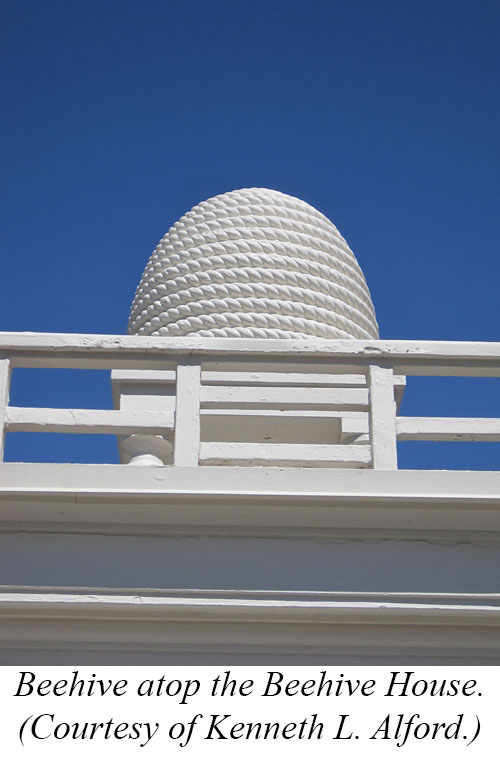
To the casual observer the link no longer depicts the passion evoked in yesteryear. Historian Dale L. Morgan writes, “‘Deseret’ is almost a lost word in Utah. It survives colorlessly, in the name of a few business firms and religious organizations. Latter-day Saint children sing hymns to “our lovely Deseret” with little understanding of the passionate devotion the name once commanded or the aspiration which it encompassed.” [32] The beehive stands alone as the symbol of Utah. It symbolizes industry and unity in strength, but little more. To the thoughtful observer, the link between the beehive and deseret still holds meaning. It is a visual reminder that an ancient people originating from the Tower of Babel roamed this land. It is a reminder that the Book of Mormon influence reaches from the sidewalks, with their honeycomb patterns, to the heavens, with beehives atop the Joseph Smith Memorial Building and the Beehive House. From top to bottom, the city of the Great Salt Lake is an expression of Book of Mormon influence. It brings to mind sacred scriptural passages: “There shall be none greater than the nation which I will raise up unto me of thy seed, upon all the face of the earth” and “whatsoever nation shall possess [the land] shall serve God, or they shall be swept off when the fulness of his wrath shall come upon them” (Ether 1:43; 2:9). For those who look for truth, the symbol of the beehive is a reminder that the influence of the Book of Mormon still holds sway in the city.
Notes
[1] Kevin L. Barney, “On the Etymology of Deseret,” BCC Papers 1/
[2] S. S. Ivins, “The Deseret Alphabet,” Utah Humanities Review 1, no. 3 (July 1947): 223.
[3] W. Jeffrey Marsh, “Brigham Young and the Book of Mormon,” Journal of Book of Mormon Studies 10, no. 2 (2001): 13.
[4] See Hugh Nibley, Lehi in the Desert; The World of the Jaredites; There Were Jaredites, vol. 5, The Collected Works of Hugh Nibley: The Book of Mormon (Salt Lake City: Deseret Book; Provo, UT: FARMS, 1988), 189–90; Hugh Nibley, “There Were Jaredites,” Improvement Era, April 1956, 244; Hugh Nibley, Abraham in Egypt (Salt Lake City: Deseret Book; Provo, UT: FARMS, 1981), 233; Jeffrey Ogden Johnson, “Deseret, State of,” in Encyclopedia of Mormonism, ed. Daniel H. Ludlow (New York: Macmillan, 1992), 1:371–73.
[5] Hugh Nibley, “The World of the Jaredites,” Improvement Era, January 1952, 22–23.
[6] Paul Hoskisson, “An Introduction to the Relevance of and a Methodology for a Study of the Proper Names of the Book of Mormon,” in By Study and Also by Faith: Essays in Honor of Hugh W. Nibley, ed. John M. Lundquist and Stephen D. Ricks (Salt Lake City: Deseret Book; Provo, UT: FARMS, 1990), 2:132.
[7] See H. L. Haywood, Symbolical Masonry (New York: George H. Doran, 1923); Henry W. Coil, A Comprehensive View of Freemasonry (Richmond, VA: Macoy Publishing, 1973).
[8] Allen E. Roberts, The Craft and Its Symbols: Opening the Door to Masonic Symbolism (Richmond, VA: Macoy Publishing, 1974), 74.
[9] Roberts, Craft and Its Symbols, 73.
[10] Freemasonry entered the town unofficially with Latter-day Saint converts who had been or still were masons.
[11] History of the Church of Jesus Christ of Latter-day Saints, ed. B. H. Roberts, 2nd ed. rev. (Salt Lake City: Deseret Book, 1957), 4:303. It should be noted that when the Nauvoo Agricultural and Manufacturing Association was organized, Brigham was in England. On February 27, 1841, the same date the act was signed, “President Brigham Young went to Manchester, and preached in Lombard Street.” History of the Church, 4:305.
[12] It should be noted that the beehive was a prominent symbol used in American communities before being introduced in Nauvoo. The beehive is found on antique clocks made in Connecticut, cast-iron string holders, ovens built with ash-chutes, and even seventeenth-century coiffures.
[13] See E. Robinson, “Special Notice,” Nauvoo Neighbor, January 10, 1844, 3; “Trades Meeting,” Nauvoo Neighbor,February 5, 1845, 3–4.
[14] Lyndon W. Cook, The Revelations of Prophet Joseph Smith: A Historical and Biographical Commentary of the Doctrine and Covenants (Provo, UT: Seventy’s Mission Bookstore, 1981), 260.
[15] There are two varieties of the token. Variety 1 does not have initials on the obverse side. Variety 2 has the initials P. H. on the obverse side below the clasped hands. The P. H. stands for Peter Haws, a private coiner indicted for counterfeiting United States coins in Nauvoo. There is no clear evidence that the motto “Union Is Strength” adopted by the second, third, fourth, and fifth wards in Salt Lake City in 1890 traces its origin to the Peter Haws brass token. See Alvin E. Rust, Mormon and Utah Coin and Currency (Salt Lake City: Rust Rare Coin, 1984), 33–35.
[16] The coining of Peter Haws in Garden Grove was unacceptable to Brigham Young. When Brigham learned that Peter Haws had a coining press in his wagon on May 12, 1846, he reproved him: “While I was standing with Prest. Kimball at his tent, an outcry was heard from Peter Haws’ Camp; . . . Haws had let Williams have some bogus money on shares. . . . I reproved them for dealing in base coin and told Haws he could not govern himself, his family, or a company; and unless he repented and forsook such dishonesty, the hand of the Lord would be against him and all those who partook of such corruption.” Manuscript History of Brigham Young, 1846–1847, ed. Elden J. Watson (Salt Lake City: J. Watson, 1971), 158.
[17] Memorial to US Congress, April 30, 1849, in Manuscript History of Brigham Young, 1847–1850, ed. William S. Harwell (Salt Lake City: Collier’s, 1997), 198. There is conjecture as to which member of the committee suggested the name Deseret. The suggestion that the name was put forward by Joseph Smith years earlier cannot be substantiated. Known sources of Joseph Smith’s words do not evidence that he spoke the word deseret.
[18] Dale L. Morgan, The State of Deseret (Logan: Utah State University Press with the Utah Historical Society, 1987), 37. The entire memorial is found in “The Constitution of the New State of Deseret,” Millennial Star, January 15, 1850, 23–25.
[19] Johnson, “Deseret, State of,” 371.
[20] See Journal History of the Church of Jesus Christ of Latter-day Saints, December 10–11, 13, 1848; March 27, 1849; and April 30, 1849, Church History Library, Salt Lake City.
[21] William S. Harwell, Manuscript History of Brigham Young, 1847–1850, 200. Five states “made a spontaneous effort at self-creation”—Texas, Franklin (“the embryo state of Tennessee”), Oregon, Deseret, and California. California was the only entity successful in achieving statehood. Morgan, State of Deseret, 7, 7n1.
[22] Morgan, State of Deseret, 121.
[23] The University of Deseret had a Deseret University Bank. For information on the bank, see Rust, Mormon and Utah Coin, 108–11.
[24] During the decade 1859–69, publications in this unique alphabet were Deseret First Book; Deseret Second Book; the Book of Mormon to the end of the Words of Mormon, designed to be the Deseret Third Book; and the complete Book of Mormon. Historian Andrew Jenson reported that even some of the Church records were inscribed in the Deseret Alphabet. Andrew Jenson, Encyclopedic History of the Church of Jesus Christ of Latter-day Saints (Salt Lake City: Deseret News, 1941), 184; Leah R. Frisby and Hector Lee, “The Deseret Readers,” Utah Humanities Review 1, no. 3 (July 1947): 240–44.
[25] The Deseret News was founded in 1850. Its columns were filled with Church-related items, Mormon theology, and values.
[26] Eliza R. Snow, “In Our Lovely Deseret,” Hymns (Salt Lake City: The Church of Jesus Christ of Latter-day Saints, 1985), no. 307.
[27] B. H. Roberts, A Comprehensive History of the Church of Jesus Christ of Latter-day Saints (Provo, UT: Brigham Young University Press, 1965), 3:492.
[28] Eugene England, Brother Brigham (Salt Lake City: Bookcraft, 1980), 159.
[29] See Rust, Mormon and Utah Coin, 74–86.
[30] Edward Leo Lyman, “Statehood for Utah,” in Utah History Encyclopedia, ed. Allan Kent Powell (Salt Lake City: University of Utah Press, 1994), 529–31.
[31] Rosemary Winters, “Funky Utah Street Names Can Hit You Where You Live,” Salt Lake Tribune, March 29, 2009.
[32] Morgan, State of Deseret, 7.
